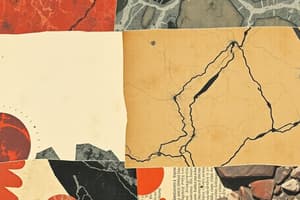Podcast
Questions and Answers
What type of lava is characterized by having large amounts of silica, being thick and slow moving, and forming light colored rocks?
What type of lava is characterized by having large amounts of silica, being thick and slow moving, and forming light colored rocks?
- Ultramafic
- Mafic
- Felsic (correct)
- Intermediate
Which type of igneous rock is formed under Earth's surface, cools slowly with larger crystals, and is known for intrusive characteristics?
Which type of igneous rock is formed under Earth's surface, cools slowly with larger crystals, and is known for intrusive characteristics?
- Pumice
- Granite (correct)
- Obsidian
- Basalt
What processes involve the movement of sediment created by wind, waves, or gravity, and breaking down rocks into smaller fragments without displacing them?
What processes involve the movement of sediment created by wind, waves, or gravity, and breaking down rocks into smaller fragments without displacing them?
- Erosion and weathering (correct)
- Sedimentation and lithification
- Weathering and metamorphism
- Deposition and compaction
Which type of sedimentary rock forms when water evaporates out of a mineral solution?
Which type of sedimentary rock forms when water evaporates out of a mineral solution?
What type of metamorphism occurs on a small and local scale when magma comes into contact with existing rock?
What type of metamorphism occurs on a small and local scale when magma comes into contact with existing rock?
How many major plates are there in Earth's crust according to the given text?
How many major plates are there in Earth's crust according to the given text?
Flashcards are hidden until you start studying
Study Notes
Igneous Rocks
- Felsic lava: high in silica, thick, slow-moving, and produces light-colored rocks
- Mafic lava: low in silica, hot, fluid, and produces dark-colored rocks
- Intrusive igneous rock: formed under Earth's surface, cools slowly, and has large crystals
- Extrusive igneous rock: formed above Earth's surface, cools quickly, and has small to no crystals
Weathering and Erosion
- Weathering: breakdown of rocks into smaller fragments without displacement
- Erosion: movement of sediment created by wind, waves, or gravity
- Weathering and erosion create sediment
Sedimentary Rocks
- Lithification: process of compacting sediments to form sedimentary rocks
- Types of sedimentary rocks:
- Chemical: formed from evaporated mineral solutions
- Organic: formed from once living organisms
- Clastic: formed from rock fragments
Metamorphism
- Contact metamorphism: local, small-scale transformation of rock when magma comes into contact with existing rock
- Regional metamorphism: large-scale transformation of rock with extreme heat and pressure, often due to plate tectonics
Plate Tectonics
- 12 major plates in the Earth's crust
Studying That Suits You
Use AI to generate personalized quizzes and flashcards to suit your learning preferences.



